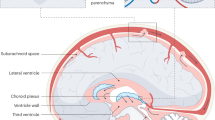Abstract
Introduction
Hydrocephalus does not indicate a single clinical entity, but includes a variety of clinicopathological conditions caused by excessive cerebrospinal fluid (CSF) based on the disturbed circulation. Recent progress in prenatal neuroimagings such as MRI and ultrasound echoencephalography on fetus enables to understand clinicopathological conditions of CSF circulation disorder in conjunction with morphological changes in the central nervous system properly. It has been revealed that the CSF dynamics develop in the theory of evolution from the immature brain, as in the animals with the minor CSF pathway predominance, towards matured adult human brain together with the completion of the major CSF pathway: the “Evolution Theory in CSF Dynamics”. Now, we can analyze CSF circulation dynamically and also analyze the flow velocity and direction of CSF movement.
Center of Excellence—Fetal Hydrocephalus Top 10 Japan
Along with this technical improvement, the standards of clinicopathological evaluation of hydrocephalus as well as the classification and concept of hydrocephalus shall undergo a major upgrade. Based on such remarkable improvement in the recent practical diagnostic evaluation of fetal hydrocephalus, it is now required to update the guideline for management and treatment of fetal and congenital hydrocephalus, and a nationwide study group; Center of Excellence—Fetal Hydrocephalus Top 10 Japan, was organized in 2008 in Japan. The retrospective analysis of 333 cases of congenital hydrocephalus indicated a fact that 43% of these cases were diagnosed prenatally, and the majority of cases were treated in these top 10 institutes in Japan. Now, congenital hydrocephalus diagnosed immediately after birth is regarded as to be based on embryonic stage; brain disorder in patients with congenital hydrocephalus should be considered in conjunction with neuronal mature process of embryonic stage. The fact is supported by the current trends in hydrocephalus research represented by “Perspective Classification of Congenital Hydrocephalus” and “Multi-categorical Hydrocephalus Classification”. The ultimate goal of hydrocephalus treatment remains achieving arrested hydrocephalus by shunt surgeries. In the future, to achieve arrested hydrocephalus, minimum quantity of CSF to be drained should be elucidated. Consideration for accurate operative indication of ETV along with new neuroendoscopic device development and analysis of CSF circulation is expected in the future. The data in this prospective multicenter analysis in this guideline are credited in Oxford Evidence level 2b (Grade II).








Similar content being viewed by others
References
Dandy WE (1918) Extirpation of the choroid plexus of the lateral ventricles in communicating hydrocephalus. Ann Surg 68:569–579
Hakim S (1964) Some observation on CSF pressure. Hydrocephalic syndrome in adult with “normal” CSF pressure: recognition of a new syndrome [Spanish]., Javeriana University School of Medicine. Bogota, Colombia, Thesis no. 957
Oi S (2010) Hydrocephalus research update—controversies in definition and classification of hydrocephalus. Neurol Med Chir Tokyo 50:859–869
Oi S (2010) A proposal of “Multi-categorical Hydrocephalus Classification”: McHC—critical review in 72,576,000 patterns of hydrocephalus. J Hydroceph 2:1–21
Oi S, Di Rocco C (2006) Proposal of “evolution theory in cerebrospinal fluid dynamics” and minor pathway hydrocephalus in developing immature brain. Childs Nerv Syst 22:662–669
Oi S, Honda Y, Hidaka M, Sato O, Matsumoto S (1998) Intrauterine high-resolution magnetic resonance imaging in fetal hydrocephalus and prenatal estimation of postnatal outcomes with “perspective classification”. J Neurosurg 88:685–694
Oi S, Kim DS, Hidaka M (2004) Hydrocephalus-parkinsonism complex: progressive hydrocephalus as a factor affecting extrapyramidal tract disorder—an experimental study. Childs Nerv Syst 20:37–40
Oi S, Luedemann W, Samii W, Samii M (2009) Evolution theory in cerebrospinal fluid dynamics: a hypothesis for failure of neuroendoscopic ventriculostomy in treatmen of hydrocephalus in fetal, neonatal and early infantile periods. J Hydroceph 1:2–10
Oi S, Shimoda M, Honda Y, Togo K, Shinoda M, Tsugano R, Sato O (2000) Pathophysiology of long-standing overt ventriculomegaly in adults. J Neurosurg 92:933–940
Russell D (1949) Observation on the pathology of hydrocephalus, Medical Research Council Special Report Series No. 265., His Majesty's Stationary Office: London. pp. 112–113.
Author information
Authors and Affiliations
Consortia
Corresponding author
Rights and permissions
About this article
Cite this article
Oi, S., Inagaki, T., Shinoda, M. et al. Guideline for management and treatment of fetal and congenital hydrocephalus: Center Of Excellence—Fetal and Congenital Hydrocephalus Top 10 Japan Guideline 2011. Childs Nerv Syst 27, 1563–1570 (2011). https://doi.org/10.1007/s00381-011-1541-7
Received:
Accepted:
Published:
Issue Date:
DOI: https://doi.org/10.1007/s00381-011-1541-7




